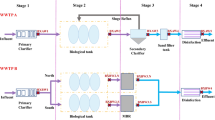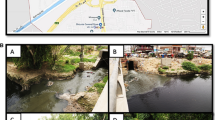Abstract
This study was conducted to evaluate the relationship between the flora and the changes in the microbial communities during tomato paste wastewater treatment. The bio-analytical techniques like Polymerase chain reaction denaturing gradient gel electrophoresis (PCR-DGGE), adenosine-triphosphate (ATP) analysis, and testing of mixed liquid and suspended solids (MLSS) were simultaneously conducted to analyze the dynamics of the microbial communities during tomato paste wastewater treatment process. The study suggests that the combined approaches of PCR-DGGE, ATP, and MLSS provided a simple and accurate method to evaluate the changes in microbial activity, microbial structure, and population size with the shift in contaminants in different treatment processes. The study also demonstrates that the structure and quantity of a microbial community are influenced by MLSS during the wastewater treatment process, which consequently determines the overall functionality of the system.
Similar content being viewed by others
References
Li, W. J., P. Cao, C. Li, and J. J. Lu (2006) Treatment of organic wastewater from tomato paste processing by coupled aerobicanaerobic process. J. Chem. Indus. Eng. 57: 2971–2975.
Wagner, M., R. Amann, and H. Lemmer (1993) Probing activated sludge with oligonucleotides specific for proteobacteria: Inadequacy of culture-dependent methods for describing microbial community structrue. Appl. Environ. Microbiol. 59: 1520–1525.
Rudolf, A., H. Lemmer, and M. Wagner (1998) Monitoring the communitystructure of wastewater treatment plants: A comparison of old and new techniques. FEMS Microbiol. Ecol. 25: 205–215.
Head, I. M., J. R. Saunders, and R. W. Pickup (1998) Microbial evolution, diversity and ecology: A decade of ribosomal RNA analysis of uncultivated microorganisms. Microbial. Ecol. 35: 1–21.
Theron, J. and T. E. Cloete (2000) Molecular techniques for determining microbial diversity and community structure in natural environments. Critic. Rev. Microbiol. 26: 37–57.
David Tilman (1996) Biodiversity: Population versus ecosystem stability. Ecol. 77: 335–363.
David Tilman (1999) The ecological consequences of changes in biodiversity: A search for general principles. Ecol. 80: 1455–1474.
Ferris, M. J., G. Muyzer, and G. Wuyzer (1996) Denaturing gradient gel electrophoresis profiles of 16S rRNA defined populations in habiting a hot spring microbial mat community. Appl. Environ. Microbiol. 62: 340–346.
Araya, R., K. Tani, T. Takagi, and M. Nasu (2003) Bacterial activity and community composition in stream water and biofilm from river determined by fluorescent in situhybridization and DGGE analysis. FEMS Microbiol. Ecol. 43: 111–119.
Muller, A. K. and K. Westergaard (2001) The effect of long-term mercury pollution on the soil microbial community. FEMS Microbiol. Ecol. 36: 11–19.
Muller, A. K., K. Westergaard, S. Christensen, and S. J. Sørensen (2002) The diversity and function of soil microbial communities exposed to different disturbances. Microbiol. Ecol. 44: 49–58.
Muyzer, G., E. C. Waal, and A. G. Uitterlinden (1993) Profiling of complexmicrobial populations by denaturing gradient gel electrophoresis analysis of polymerase chain reaction amp lified genes encoding for 16S rRNA. Appl. Environ. Microbiol. 59: 695–700.
Wen, S. M., C. Li, J. J. Lu, and P. Cao (2009) Comparative study on the properties of aerobic strains in an aerobic-anaerobic coupled reactor. J. Chem. Indus. Eng. 60: 2067–2073.
Chinese Environment Protection Agency (1996) Integrated wastewater discharge standard (GB 8978-1996). Beijing: China Environmental Science Press.
Wei, F. S. (2002) National environmental protection agency, monitoring, and analysis method of water and wastewater. Beijing: China Environmental Science Press.
State Environmental Protection Administration (2002) Monitoring and analytical method for water and wastewater. 4th ed., Beijing: China Environment Publishing House.
Yu, Q. X., G. Q. Wu, and X. T. Meng (1990) Handbook of environmental engineering microbiological study. Beijing: China Environmental Science Press.
Altschul, S. F., T. L. Madden, A. A. Schaffer, J. Zhang, Z. Zhang, W. Miller, and D. J. Lipman (1997) Gapped BLAST and PSIBLAST: A new generation of protein database search programs. Nucl. Acids Res. 25: 3389–3402.
Cao, P., C. Li, S. M. Wen, Y. B. Tong, and J. R. Ni (2011) Effect of adapted constructed flora on continuous coupled aerobic-anaerobic process for treatment of tomato paste wastewater. Fresenius Environ. Bull. 20: 1649–1654.
Cao, P., Y. B. Tong, J. Yan, and Z. G. Sheng (2011) Industrial application of aerobic strains to the degradation of wastewater from tomato paste processing. Indus. Water Treatment. 31: 82–85.
Sun, S. Y., Z. G. Guo, R. L. Yang, and P. Cao (2012) Study on the triphenyl tetrazolium chloride-dehydrogenase activity (TTCDHA) method in determination of bioactivity for treating tomato paste wastewater. Afric. J. Biotechnol. 11: 7055–7062.
Sun, S. Y., Z. G. Guo, R. L. Yang, and P. Cao (2012) Evaluation for biological activity of aerobic activated sludge in wastewater treatment system for tomato processing. J. Chem. Indus. Eng. 63: 2210–2216.
Low, E. W. and H. A. Chase (1999) Reducing production of excess biomass during wastewater treatment. Water Res. 33: 1119–1121.
Tchobanoglous, G. and F. L. Burton (1991) Wastewater engineering: Treatment, disposal and reuse. 3rd ed., New York: McGraw-Hill, Inc.
Gohil, A. and G. Nakhla (2006) Treatment of tomato processing wastewater by an upflow anaerobic sludge blanket-anoxic-aerobic system. Bioresour. Technol. 97: 2141–2152.
Ritchelita, P. G., E. Agustiani, U. B. Aloysius, K. Ito, and M. Okada (1999) Effect of HRT and MLSS on THM precursor removal in the activated sludge process. Water Res. 33: 131–136.
Rory, A. C., C. William Yeung, C. W. Greer, W. Douglas Gould, S. Mortazavi, P. L. Bédard, L. Morin, L. Lortie, O. Dinardo, and K. J. Kennedy (2010) The bacterial community structure during bioleaching of a low-grade nickel sulphide ore in stirred-tank reactors at different combinations of temperature and pH. Hydrometall. 104: 207–215.
Yang, Q. X., J. Wang, H. T. Wang, X. Y. Chen, S. W. Ren, X. L. Li, Y. Xu, H. Zhang, and X. M. Li (2012) Evolution of the microbial community in a full-scale printing and dyeing wastewater treatment system. Bioresour. Technol. 117: 155–163.
Briones, A. and L. Raskin (2003) Diversity and dynamics of microbial communities in engineered environments and their implications for process stability. Curr. Opin. Biotechnol. 14: 270–276.
Prakitchaiwattana, C., G. Fleet, and G. Heard (2004) Application and evaluation of denaturing gradient gel electrophoresis to analyse the yeast ecology of wine grapes. FEMS Yeast Res. 4: 865–877.
Chen, G. H., H. K. Mo, S. Saby, W. K. Yip, and Y. Liu (2000) Minimization of activated sludge production by chemicallly stimulated energy spilling. Water Sci. Technol. 42: 189–200.
Feng, Q. N., A. F. Yu, L. B. Chu, H. Z. Chen, and H. X. Xin (2012) Mechanistic study of on-site sludge reduction in a baffled bioreactor consisting of three series of alternating aerobic and anaerobic compartments. Biochem. Eng. J. 67: 45–51.
Author information
Authors and Affiliations
Corresponding author
Rights and permissions
About this article
Cite this article
Sun, S., Guo, Z., Yang, R. et al. Analysis of microbial diversity in tomato paste wastewater through PCR-DGGE. Biotechnol Bioproc E 18, 111–118 (2013). https://doi.org/10.1007/s12257-012-0155-6
Received:
Revised:
Accepted:
Published:
Issue Date:
DOI: https://doi.org/10.1007/s12257-012-0155-6




